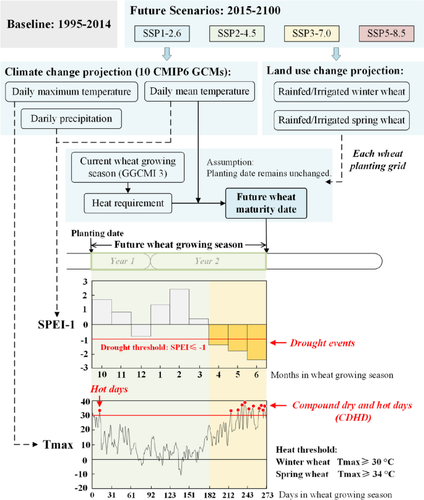Climatic Change ( IF 4.8 ) Pub Date : 2024-04-10 , DOI: 10.1007/s10584-024-03718-1 Yan He , Yanxia Zhao , Shao Sun , Jiayi Fang , Yi Zhang , Qing Sun , Li Liu , Yihong Duan , Xiaokang Hu , Peijun Shi

|
Compound dry and hot extremes are proved to be the most damaging climatic stressor to wheat thereby with grave implications for food security, thus it is critical to systematically reveal their changes under unabated global warming. In this study, we comprehensively investigate the global change in compound dry and hot days (CDHD) within dynamic wheat growing seasons during 2015–2100 under 4 socio-economic scenarios (SSP1-2.6, SSP2-4.5, SSP3-7.0 and SSP5-8.5) based on the latest downscaled Coupled Model Intercomparison Project Phase 6 (CMIP6) models. Our results demonstrate a notable increase in CDHD’s frequency (\({CDHD}_{f}\)) and severity (\({CDHD}_{s}\)) worldwide under all SSPs, such increase is sharper over southern Asia in winter wheat growing season, and southern Canada, northern America, Ukraine, Turkey and northern Kazakhstan in spring wheat growing season. As the top 10 wheat producer, India and America will suffer much more detrimental CDHD in their wheat growing season. Adopting a low forcing pathway will mitigate CDHD risks in up to 93.3% of wheat areas. Positive dependence between droughts and heats in wheat growing season is found over more than 74.2% of wheat areas, which will effectively promote the frequency and severity of CDHD. Global warming will dominate the increase of CDHD directly by increasing hot days and indirectly by enhancing potential evapotranspiration thereby aggravating droughts. This study helps to optimize adaptation strategies for mitigating CDHD risks on wheat production, and provides new insights and analysis paradigm for investigating future variations in compound extremes occurring within dynamic crops growing seasons.
中文翻译:

全球变暖决定了未来全球小麦生长季复合干热天数的增加
事实证明,复合干热极端天气是对小麦最具破坏性的气候压力源,从而对粮食安全产生严重影响,因此系统地揭示其在全球变暖趋势下的变化至关重要。在本研究中,我们全面研究了 4 种社会经济情景(SSP1-2.6、SSP2-4.5、SSP3-7.0 和 SSP5-8.5)下 2015-2100 年动态小麦生长季内的全球复合干热天数(CDHD)变化。 )基于最新缩小比例的耦合模型比对项目第 6 阶段 (CMIP6) 模型。我们的结果表明,在所有 SSP 下,全球范围内 CDHD 的频率 ( \({CDHD}_{f}\) ) 和严重程度 ( \({CDHD}_{s}\) ) 显着增加,这种增加在南亚地区更为明显冬小麦生长季节,加拿大南部、北美、乌克兰、土耳其和哈萨克斯坦北部春小麦生长季节。作为世界十大小麦生产国,印度和美国在小麦生长季节将遭受更为严重的CDHD。采用低强迫途径将减轻高达 93.3% 小麦种植区的 CDHD 风险。超过74.2%的麦区发现小麦生长季干旱与高温存在正相关关系,这将有效促进CDHD的发生频率和严重程度。全球变暖将通过增加炎热天数直接主导CDHD的增加,并通过增加潜在蒸散量从而加剧干旱间接主导CDHD的增加。这项研究有助于优化适应策略,以减轻小麦生产上的 CDHD 风险,并为研究动态作物生长季节内发生的复合极端事件的未来变化提供新的见解和分析范式。



























 京公网安备 11010802027423号
京公网安备 11010802027423号